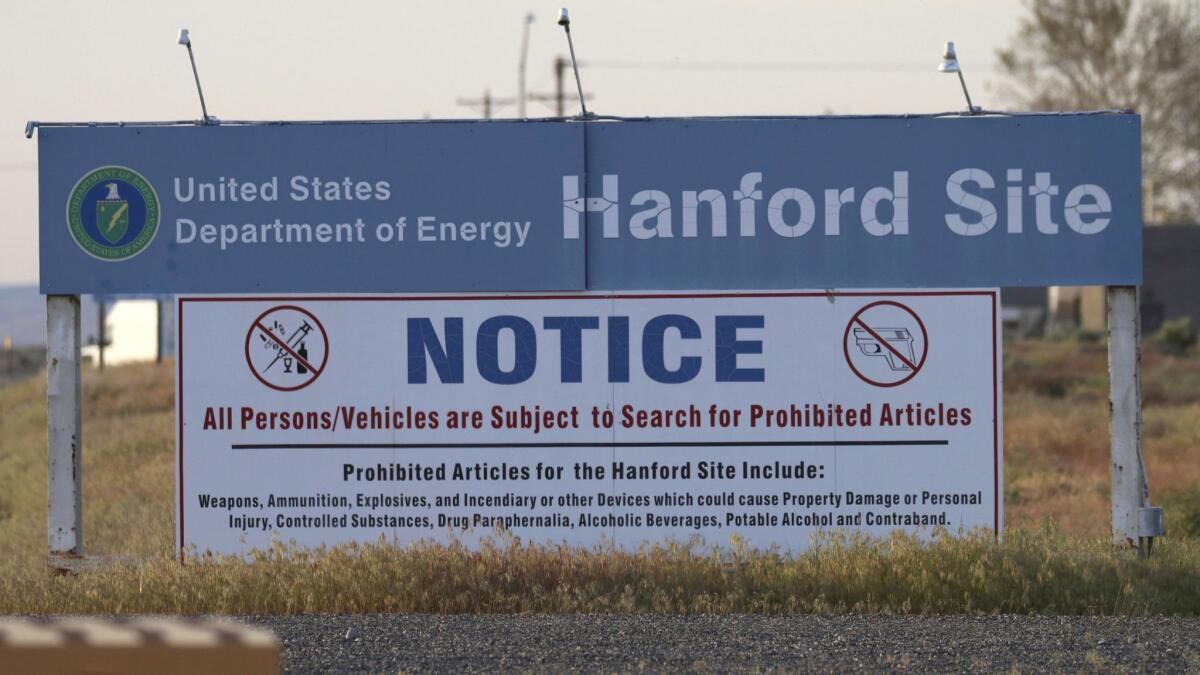Nuclear waste will be classified as safer under a controversial Trump administration change

- Share via
The federal Department of Energy is changing how it will dispose of nuclear weapons waste, reclassifying what was formerly considered high-level radioactive material to a lower standard, officials said in a formal notice Wednesday.
The new approach triggered immediate opposition in Washington state, South Carolina and Idaho, which contend that the Energy Department wants to bury dangerous waste in shallow pits.
Paul Dabbar, the department’s undersecretary for science, said the approach will allow for faster cleanup of contaminated areas and lower cleanup costs, and bring a more realistic approach to public health and safety.
The Energy Department “is going to analyze each waste stream and manage it in accordance with Nuclear Regulatory Commission standards, with the goal of getting the lower-level waste out of these states without sacrificing public safety,” Dabbar said.
Washington Gov. Jay Inslee, who is running for the Democratic nomination for president, said the move is illegal.
“By taking this action, the administration seeks to cut out state input and move towards disposal options of their choosing, including those already deemed to be unsafe by their own assessments and in violation of the existing legally binding agreement,” he said. “We will consider all options to stop this reckless and dangerous action.”
The change would affect sludge and other waste in the three states, where the Energy Department reprocessed nuclear rods for decades to extract plutonium for hydrogen bombs. The operations left behind millions of gallons of highly radioactive material in underground tanks that have proven difficult, if not impossible, to safely discard.
From the archives: Toxic legacy of the Cold War »
The waste includes isotopes of iodine, strontium, americium, plutonium, uranium and other unstable elements, many of which are toxic as well as radioactive. Much of the sludge is stored in single-wall underground tanks that have leaked.
The Energy Department spends about $6 billion annually to clean up the mess it left behind across the nation, but in some cases has made little progress. The most expensive site is in Washington, where construction of a massive treatment complex has been at a virtual standstill since 2012.
Under the old interpretation, any waste product that was created during reprocessing was automatically classified as high-level waste. The new interpretation would be based on the waste’s level of radioactivity, not its origin.
Tom Carpenter, executive director of Hanford Challenge in Washington state, said it isn’t the level of radioactivity that makes certain wastes deadly, but rather the longevity of their emissions and their specific effect on biology. Carpenter said the ultimate aim of the plan is to leave sludge in the tanks.
“They want to get out of the cleanup and this will make it cheaper,” he said.
Geoff Fettus, an attorney at the Natural Resources Defense Council, said the Trump administration is attempting to alter five decades of national consensus on handling the most toxic waste in the world.
“No matter what they call it, this waste needs a permanent, well-protected disposal option to guard it for generations to come,” he said.
More to Read
Sign up for Essential California
The most important California stories and recommendations in your inbox every morning.
You may occasionally receive promotional content from the Los Angeles Times.














